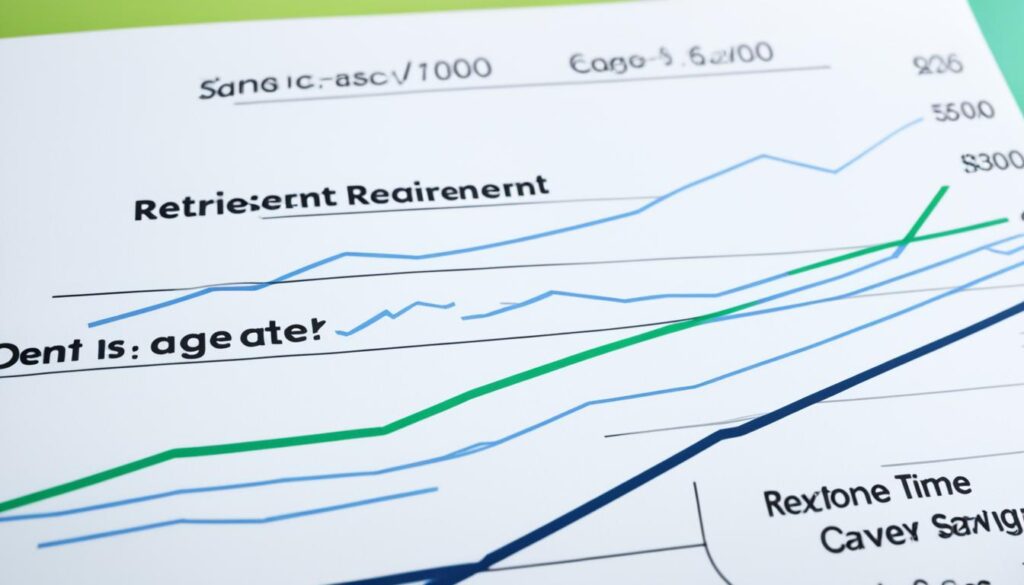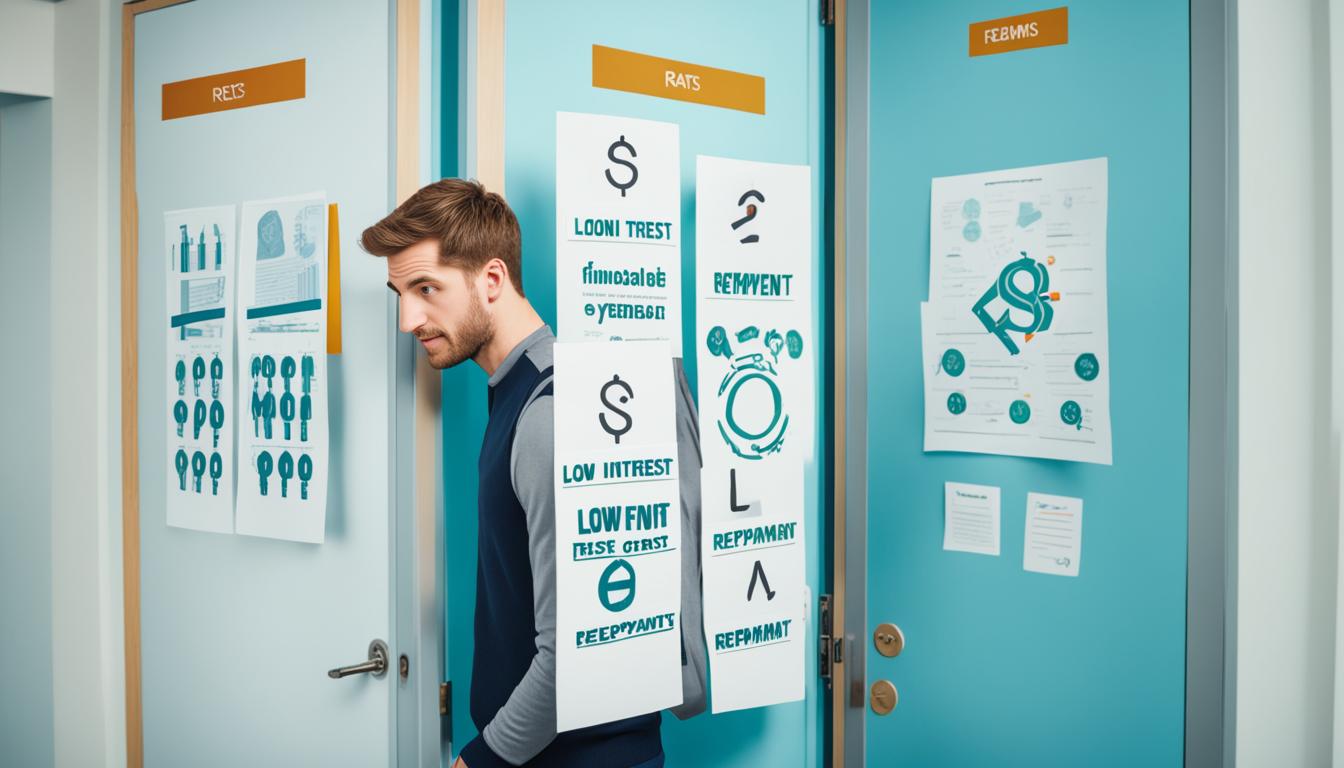Planning for retirement is crucial for a stable financial future. Many Americans are falling behind on saving. A Bankrate survey shows that 56% of them are not saving enough for retirement.
To secure your financial future, it’s key to look at various retirement plans. This article will discuss the best retirement savings options. It will guide you to make wise financial choices. Whether you are starting to save or want to enhance your plan, this information is for you.
Learning about the best retirement savings plans is important. These plans have tax benefits and employer matches. They also offer different ways to invest. A good retirement savings plan helps create a stable future.
In later sections, we will detail different types of retirement savings plans. This includes 401(k)s, IRAs, and more. We’ll also talk about employer-backed plans and their benefits. By learning about these plans, you can choose one that meets your future needs.
Defined Contribution Plans
Since the 1980s, defined contribution plans like 401(k)s have changed how we think about retirement. A study found that now, 86% of the largest companies offer these plans only. With these plans, workers can put money from their paychecks into special retirement accounts.
There are a few different kinds of these plans:
- 401(k)s: These are for people working at private companies. They let employees save part of their pay for retirement. Often, the company will also add some money to the employee’s savings.
- 403(b)s: These are for those working at public schools, hospitals, and certain nonprofits. They work a lot like 401(k)s, where money saved isn’t taxed until you use it in retirement.
- 457(b)s: For state and local government workers, these plans help you save part of what you make before taxes for when you retire.
With these plans, you’re in charge of where your money goes. You can pick from different kinds of investments based on what feels right for you.
Key Benefits of Defined Contribution Plans
These plans come with a lot of good points:
- Tax Advantages: The money you put in isn’t taxed yet, so it can grow without that worry until you retire. This might help you save more over time.
- Employer Contributions: Sometimes, your employer will also save with you. They’ll match what you save, or add a bit of money to your account. It’s like extra money for your retirement fund.
- Flexibility: You get to choose how your money is invested. You can pick from different types of stocks, bonds, or mutual funds, depending on what you’re comfortable with.
These plans have really become a big part of preparing for retirement. They offer you the chance to build a strong financial future for yourself.
Individual Retirement Accounts (IRAs)
Individual Retirement Accounts (IRAs) help people save for retirement. There are different types to fit various financial goals. Let’s explore the main IRAs and what they offer.
Traditional IRA
A traditional IRA lets you put in money before taxes. This lowers what you owe on taxes for that year. Your money and earnings then grow tax-free until you take it out in retirement.
Roth IRA
With a Roth IRA, you pay taxes on your money before you put it in. But, when you withdraw the money in retirement, it’s all tax-free. This is great if you think you’ll earn more in the future and be in a higher tax bracket.
Spousal IRA
Spousal IRAs help married couples where one doesn’t work. It enables the non-working spouse to save in an IRA. Even without a job, they can enjoy the tax benefits.
Fixed Annuities
Fixed annuities are another good option for retirement. You give an amount to an insurance company and they pay you back regularly. This way, you’ll have a steady income in retirement. Plus, the money grows without taxes until you use it.
Mixing traditional, Roth IRAs, and fixed annuities can give you a strong retirement plan. speak to a financial expert to design the best plan for you.

| Type of IRA | Tax Treatment | Contributions | Withdrawals |
|---|---|---|---|
| Traditional IRA | Pre-tax | Tax-deductible | Taxable |
| Roth IRA | After-tax | N/A | Tax-free |
| Spousal IRA | Pre-tax | Tax-deductible | Taxable |
Best Employer-Sponsored Retirement Plans
Many employers provide employer-sponsored retirement plans to help with retirement savings. These plans make it easy and systematic for employees to build their future fund. Here we’ll look into some great options you might find.
1. Traditional 401(k) Plans
Traditional 401(k) plans are very popular with employers. They let you put some of your paycheck into your retirement account before taxes. This helps your money grow without tax until you take it out for retirement. It’s a smart way to build up your savings.
2. Roth 401(k) Plans
Roth 401(k) plans offer something different from the traditional ones. With a Roth 401(k), you use money that’s already been taxed but won’t get taxed again when you take it out for retirement. This can be a better choice for some, especially those who think their taxes might be higher in the future.
3. 403(b) Plans
Non-profit groups like schools or hospitals often offer 403(b) plans. These are like traditional 401(k)s, where you can add part of your income before paying taxes. The money and anything it earns is tax-free until you withdraw it. Ideal for some tax savings.
4. 457(b) Plans
For those working in local or state governments, there’s the 457(b) plan. It also lets you save before taxes, meaning you keep more of your money now. Since taxes are delayed on your savings, this can be a win for your retirement budget.
5. Thrift Savings Plan (TSP)
Federal employees and some military members can sign up for The Thrift Savings Plan (TSP). Both traditional and Roth contributions are welcome. It’s known for its low fees and diverse investment choices, helping your money grow over time.
These retirement options come with tax perks, sometimes extra help from your employer, and a clear plan for saving up for the future. The details of what you’re offered will depend on where you work. It’s important to look closely at each plan to see how they match your financial goals for the future.
Other Retirement Savings Accounts
Aside from defined contribution plans and IRAs, you have more choices for saving for retirement. These options can help make your financial future more secure.
Defined Benefit Plans
Defined benefit plans, known as pensions, give you a sure retirement benefit. This is based on your years worked and salary. They offer a steady income in retirement, which helps feel secure.
Many employers, especially in the government and big companies, provide these plans.
Guaranteed Income Annuities (GIAs)
Guaranteed income annuities promise a fixed income, either for a set time or your entire life. They ensure you always have money to cover your needs in retirement.
Cash-Balance Plans
Cash-balance plans are a mix of defined benefit and defined contribution plans. They promise a set retirement benefit based on your salary and years of work. You can carry over your cash balance if you switch jobs.
Cash-Value Life Insurance Plans
Whole life or universal life insurance can be used for retirement saving. These plans pay a death benefit and grow a cash value. This cash can be used in retirement as an extra source of money.
Nonqualified Deferred Compensation Plans
Special retirement savings plans are open to well-paid workers. With these plans, part of your salary or bonuses is set aside until later. You pay taxes only when the money is taken out, often in retirement.
Remember to look at all your options for retirement saving. Each choice has its own benefits and uses. Think about what you want and need for your future before deciding.
Key Considerations for Retirement Plans
When planning for your retirement, it’s vital to think about many factors. Knowing the rules for joining and how much you can put in retirement plans is important. It’s key for making smart choices. Also, think about how you invest and how much risk you’re okay with.
Eligibility Criteria and Contribution Limits
To join certain retirement plans, you need to meet specific age or work years. Knowing these rules is crucial. Every plan also has a max amount you can put in yearly. Going over this cap may lead to tax fines. So, stick to these limits to avoid problems.
Investment Strategy and Risk Tolerance
How you invest can really affect your savings. Some plans let you choose safer or more risky ways to invest. Pick what fits how much risk you can take. If you don’t like risk, pick safer options. If you’re okay with risk, you might go for options that could pay off more.
Choosing the Right Retirement Plan
It’s essential to look at your goals when checking out retirement plans. One plan might offer higher limits to put in, while another might have more varied investments. Think about fees and what help your job might offer too. By doing this, you can find the best plan for you.
Getting Started with Retirement Savings
Planning for retirement is crucial. Start early to secure your long-term financial future. Here are steps to begin:
Assess Your Current Financial Situation
First, look at what you have financially. Check your income, expenses, and any savings or investments. This helps you see where you’re at and what you can save for retirement.
Set Realistic Goals for Retirement
Next, set goals for retirement that are realistic. Think about when you want to retire, your lifestyle hopes, and healthcare costs. Knowing your retirement dreams allows you to set a saving amount and plan clearly.
Utilize Retirement Calculators and Online Tools
Use retirement calculators to see how much to save. These tools look at inflation, investment returns, and how long you might live. You’ll get a target amount to aim for by entering your details.

Create a Budget and Set Regular Contributions
A budget is key for effective saving. Make a budget that includes saving for retirement. This way, you make saving a regular thing, helping you meet your future needs.
Consider Automating Your Savings
Automating your savings can simplify things. Arrange for a part of your paycheck to go straight into your retirement account. This way, you won’t forget to save, and you’ll keep building your retirement fund.
Choosing the Best Investment Strategy for Retirement
Finding the best investment strategy is key to ensuring your retirement funds grow steadily. Consider important factors like how you spread out your money, mixing up your investments, and how much risk you’re willing to take. These steps will help you make a solid plan that fits your retirement dreams.
Asset Allocation
Deciding where to put your money is crucial for a good investment plan. You should divide your money among different types of investments, like stocks, bonds, and cash. This mix helps lower your risks and aims for higher returns. It’s vital to find the right mix of stocks, which can grow fast but also fall, and bonds, which offer more steady earnings.
Diversification
Diversification is also key. It means spreading your money across many types of assets and places. By doing this, you protect your savings from big hits that could come from any single bad event. Instead of just investing in one company, you’d put your money in several different areas. This way, if one area does poorly, your whole savings won’t suffer as much.
Risk Tolerance
Understanding how much risk you’re okay with is very important. Your comfort with market ups and downs affects your investment choices. If you can handle more risk, you might choose investments that could grow quickly but are less stable. If you’re not as comfortable with risk, you might focus on safer, but less profitable, options. Figuring out your risk tolerance helps make sure your investment plan matches your retirement goals.
Remember, your own situation and goals are what matter most when plotting your investment strategy. If you’re unsure of what to do, it’s always wise to talk to a financial advisor. They can offer advice that’s specifically for you, guiding you towards the best choices.
Conclusion
Planning for retirement is essential for your financial safety in the long run. It’s important to look into the best retirement saving plans. This way, you can make choices that secure your future. You might pick 401(k)s, IRAs, or other saving accounts. Knowing your options and key points is crucial for meeting your retirement plans.
Begin saving for your retirement as soon as you can. Add money regularly to lay a strong base for the future. Using savings plans can boost your savings and ensure a relaxed retirement. Don’t delay this important step. Choose to secure your financial future now.
Think of retirement as a journey. The choices you make today will shape your tomorrow. Educate yourself well, and seek advice from pros if you need it. Make choices based on what you learn. With a solid plan and wise money moves, your dream retirement is possible.
FAQ
What are defined contribution plans?
Defined contribution plans let workers set aside part of their pay before taxes for retirement. This money goes to their own retirement accounts. Examples include 401(k)s and 403(b)s for teachers.
What are Individual Retirement Accounts (IRAs)?
IRAs are accounts for retirement savings. There are two main types. With traditional IRAs, you put in money before taxes. With Roth IRAs, it’s after taxes but you don’t pay tax when you take it out.
There are also special IRAs for married couples where one spouse doesn’t work. They can save too. Here is more info on spousal IRAs.
What are the best employer-sponsored retirement plans?
Many companies offer good retirement plans. Some let you save before taxes, like regular 401(k)s. Others, like Roth 401(k)s, let you take it out tax-free. Nonprofits and government jobs might have 403(b) or 457(b) plans.
Federal employees can use the Thrift Savings Plan (TSP) for retirement. It’s a good option too.
What are other retirement savings accounts worth considering?
There are more ways to save for retirement. Pension plans give you a set amount when you retire, based on your job and years working. GIAs and cash-balance plans are other options.
Life insurance plans and extra retirement saving accounts are available too. They all help you save for when you’re no longer working.
What are the key considerations for retirement plans?
It’s important to look at many things when choosing a plan. Check who can join and how much you can save. Also, think about how much risk you’re willing to take with your money.
Each plan has different ways to invest your money. Pick one that fits with what you want for your future.
How do I get started with retirement savings?
Starting to save for retirement means knowing your money now and what you need later. Figure out how much to save with online tools. Make a plan to save regularly.
Setting up automatic saving can help you build up your money without thinking about it every paycheck.
How do I choose the best investment strategy for retirement?
Picking a good way to invest for retirement matters a lot. Look at how you spread your money out and how safe you want to be. Putting money in different things and places is smart but check on your risk comfort too.
This balance helps your money grow over time without being too risky.
Why is planning for retirement essential?
Getting ready for retirement is key for a good financial future. Find the best ways to save and be smart with your money. Start saving early and you’ll be better off later on.


















